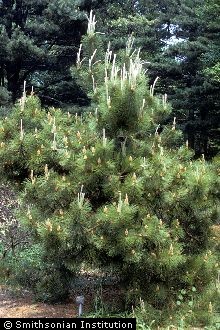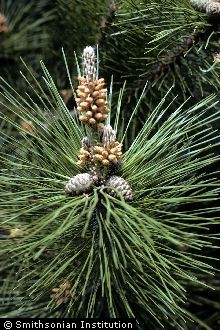Pinus thunbergiana Franco
Scientific Name: Pinus thunbergiana Franco

| General Information | |
|---|---|
| Usda Symbol | PITH3 |
| Group | Gymnosperm |
| Life Cycle | Perennial |
| Growth Habits | Tree |
| Native Locations | PITH3 |
Plant Guide
Use soil moisture sensors to measure the soil moisture of Pinus thunbergiana Franco.
Fact Sheet
Alternate Names
Pinus thunbergiana Franco
Uses
Japanese black pine had been among the best species for planting along Northeastern seashores until about 1990. The species has suffered from insects and diseases and has fallen rapidly in esteem.
Status
Please consult the PLANTS Web site and your State Department of Natural Resources for this plant’s current status (e.g. threatened or endangered species, state noxious status, and wetland indicator values).
Description
Japanese black pine is an introduced evergreen. In its most favorable habitat, Japanese black pine can reach a height of 100 feet, but in beach plantings, it is usually less than 20 feet tall. Its spreading, loosely swaying branches are orange-yellow in color, and form an irregular silhouette. The blackish-gray bark is furrowed into irregular plates. Its evergreen foliage consists of bright green bundles of 2 stiff, sharp-pointed needles, 3-5 inches long. The large, grayish-white terminal buds are oblong, with fringed scales at the tips. After 4 or 5 years of age, nut-brown colored, short-stalked cones, 2-3 inches long, are produced. Fruiting and seed production are usually prolific. There are 34,000 seeds per pound.
Adaptation and Distribution
Distribution , Use soil moisture sensors to measure the soil moisture of Pinus thunbergiana Franco.
Distribution
This pine is adaptable and will grow on a wide variety of soils under adverse conditions. Japanese black pine exhibits excellent drought tolerance but poor shade tolerance; it tolerates moderately well-drained soils. This pine is more salt-spray resistant than any of the native pines. Japanese black pine is distributed primarily throughout the eastern United States. For a current distribution map, please consult the Plant Profile page for this species on the PLANTS Web site.
Establishment
Japanese black pine typically grows on medium fertility, slightly acid, loamy to sandy soils. Establishment is by planting bare-root or container-grown plants 2-3 years old. On sand dunes, the use of container-grown plants is recommended. It may be established using bare-root two-year-old seedlings where soil and moisture conditions are good for plant establishment. It is desirable to dig a hole 2-3 times larger than the container, backfill with peat moss, then mix thoroughly with the sand. Place the roots in the hole and backfill around them. Water immediately. Japanese black pine is grown in nurseries from seed, using conventional propagation practices.
Management
Some protection from strong winds the first and second years may improve survival. Average growth is 12-18 inches per year.
Plant Traits
Growth Requirements
| Temperature, Minimum (°F) | -3 |
|---|---|
| Adapted to Coarse Textured Soils | Yes |
| Adapted to Fine Textured Soils | No |
| Adapted to Medium Textured Soils | Yes |
| Anaerobic Tolerance | None |
| CaCO3 Tolerance | Medium |
| Cold Stratification Required | Yes |
| Drought Tolerance | Medium |
| Fertility Requirement | Low |
| Fire Tolerance | Low |
| Frost Free Days, Minimum | 155 |
| Hedge Tolerance | Low |
| Moisture Use | Medium |
| pH, Maximum | 8.0 |
| pH, Minimum | 5.5 |
| Planting Density per Acre, Maxim | 1200 |
| Planting Density per Acre, Minim | 430 |
| Precipitation, Maximum | 60 |
| Precipitation, Minimum | 30 |
| Root Depth, Minimum (inches) | 24 |
| Salinity Tolerance | Medium |
| Shade Tolerance | Intolerant |
Morphology/Physiology
| Bloat | None |
|---|---|
| Toxicity | None |
| Resprout Ability | No |
| Shape and Orientation | Erect |
| Active Growth Period | Spring |
| C:N Ratio | High |
| Coppice Potential | No |
| Fall Conspicuous | No |
| Fire Resistant | No |
| Flower Conspicuous | No |
| Foliage Color | Green |
| Foliage Porosity Summer | Dense |
| Foliage Porosity Winter | Dense |
| Foliage Texture | Coarse |
| Fruit/Seed Conspicuous | No |
| Nitrogen Fixation | None |
| Low Growing Grass | No |
| Lifespan | Long |
| Leaf Retention | Yes |
| Known Allelopath | No |
| Height, Mature (feet) | 25.0 |
| Height at 20 Years, Maximum (fee | 50 |
| Growth Rate | Moderate |
| Growth Form | Single Stem |
| Fruit/Seed Color | Brown |
Reproduction
| Vegetative Spread Rate | None |
|---|---|
| Small Grain | No |
| Seedling Vigor | Medium |
| Seed Spread Rate | Slow |
| Seed per Pound | 34080 |
| Fruit/Seed Persistence | No |
| Propagated by Tubers | No |
| Propagated by Sprigs | No |
| Propagated by Sod | No |
| Propagated by Seed | Yes |
| Propagated by Corm | No |
| Propagated by Cuttings | No |
| Bloom Period | Spring |
| Commercial Availability | Routinely Available |
| Fruit/Seed Abundance | Medium |
| Fruit/Seed Period Begin | Spring |
| Fruit/Seed Period End | Summer |
| Propagated by Bare Root | Yes |
| Propagated by Bulb | No |
| Propagated by Container | Yes |
Suitability/Use
| Veneer Product | No |
|---|---|
| Pulpwood Product | No |
| Protein Potential | Low |
| Post Product | No |
| Palatable Human | No |
| Palatable Graze Animal | Low |
| Palatable Browse Animal | Low |
| Nursery Stock Product | Yes |
| Naval Store Product | No |
| Lumber Product | No |
| Fuelwood Product | Low |
| Fodder Product | No |
| Christmas Tree Product | No |
| Berry/Nut/Seed Product | No |

